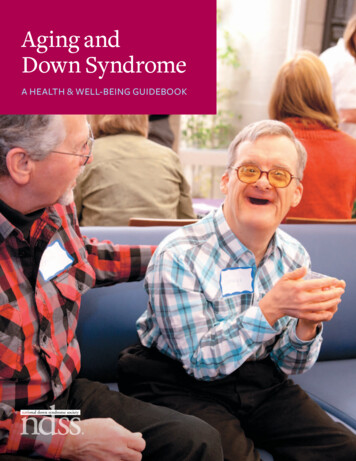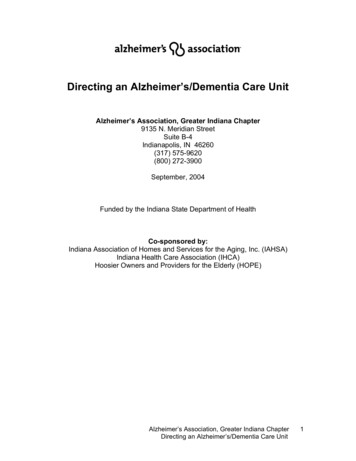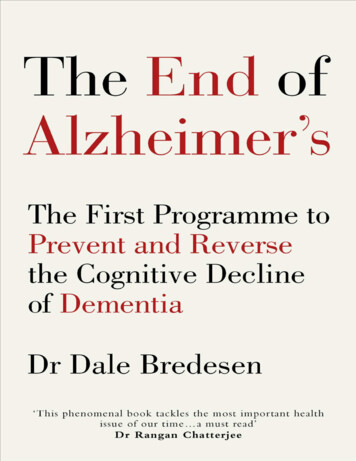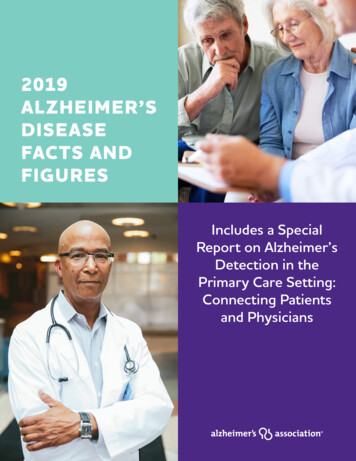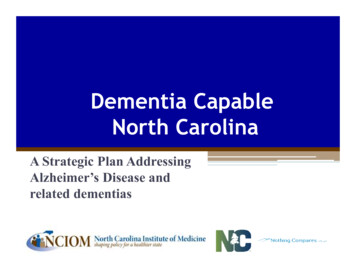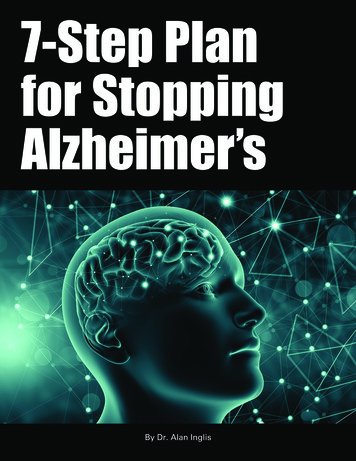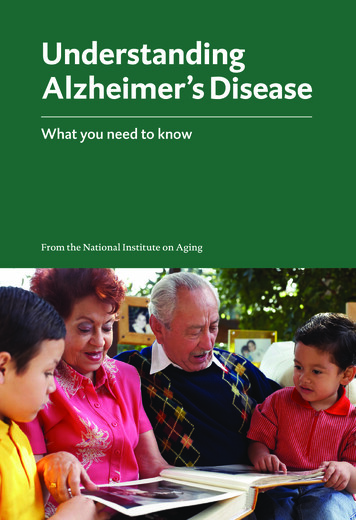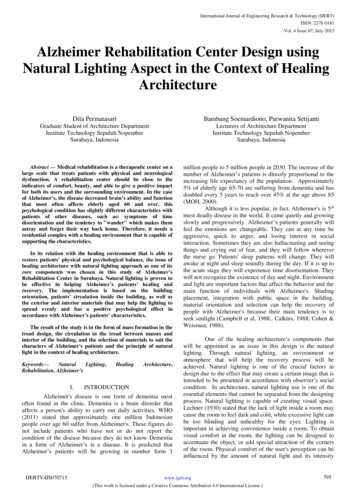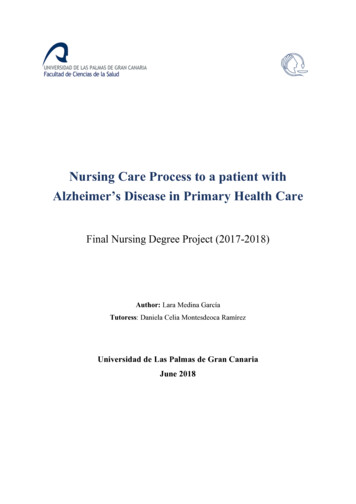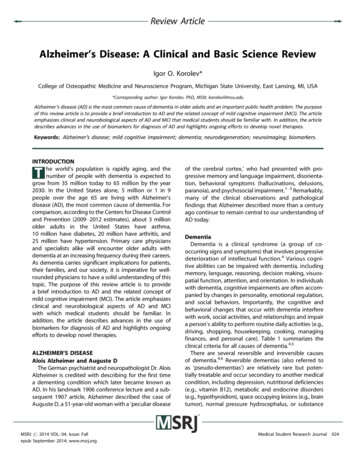
Transcription
Review ArticleAlzheimer’s Disease: A Clinical and Basic Science ReviewIgor O. Korolev*College of Osteopathic Medicine and Neuroscience Program, Michigan State University, East Lansing, MI, USA*Corresponding author: Igor Korolev, PhD, MSIII; korolevi@msu.eduAlzheimer’s disease (AD) is the most common cause of dementia in older adults and an important public health problem. The purposeof this review article is to provide a brief introduction to AD and the related concept of mild cognitive impairment (MCI). The articleemphasizes clinical and neurobiological aspects of AD and MCI that medical students should be familiar with. In addition, the articledescribes advances in the use of biomarkers for diagnosis of AD and highlights ongoing efforts to develop novel therapies.Keywords: Alzheimer’s disease; mild cognitive impairment; dementia; neurodegeneration; neuroimaging; biomarkers.INTRODUCTIONhe world’s population is rapidly aging, and thenumber of people with dementia is expected togrow from 35 million today to 65 million by the year2030. In the United States alone, 5 million or 1 in 9people over the age 65 are living with Alzheimer’sdisease (AD), the most common cause of dementia. Forcomparison, according to the Centers for Disease Controland Prevention (2009 2012 estimates), about 3 millionolder adults in the United States have asthma,10 million have diabetes, 20 million have arthritis, and25 million have hypertension. Primary care physiciansand specialists alike will encounter older adults withdementia at an increasing frequency during their careers.As dementia carries significant implications for patients,their families, and our society, it is imperative for wellrounded physicians to have a solid understanding of thistopic. The purpose of this review article is to providea brief introduction to AD and the related concept ofmild cognitive impairment (MCI). The article emphasizesclinical and neurobiological aspects of AD and MCIwith which medical students should be familiar. Inaddition, the article describes advances in the use ofbiomarkers for diagnosis of AD and highlights ongoingefforts to develop novel therapies.ALZHEIMER’S DISEASEAlois Alzheimer and Auguste DThe German psychiatrist and neuropathologist Dr. AloisAlzheimer is credited with describing for the first timea dementing condition which later became known asAD. In his landmark 1906 conference lecture and a subsequent 1907 article, Alzheimer described the case ofAuguste D, a 51-year-old woman with a ‘peculiar diseaseMSRJ # 2014 VOL: 04. Issue: Fallepub September 2014; www.msrj.orgof the cerebral cortex,’ who had presented with progressive memory and language impairment, disorientation, behavioral symptoms (hallucinations, delusions,paranoia), and psychosocial impairment.1 3 Remarkably,many of the clinical observations and pathologicalfindings that Alzheimer described more than a centuryago continue to remain central to our understanding ofAD today.DementiaDementia is a clinical syndrome (a group of cooccurring signs and symptoms) that involves progressivedeterioration of intellectual function.4 Various cognitive abilities can be impaired with dementia, includingmemory, language, reasoning, decision making, visuospatial function, attention, and orientation. In individualswith dementia, cognitive impairments are often accompanied by changes in personality, emotional regulation,and social behaviors. Importantly, the cognitive andbehavioral changes that occur with dementia interferewith work, social activities, and relationships and impaira person’s ability to perform routine daily activities (e.g.,driving, shopping, housekeeping, cooking, managingfinances, and personal care). Table 1 summarizes theclinical criteria for all causes of dementia.4,5There are several reversible and irreversible causesof dementia.4,6 Reversible dementias (also referred toas ‘pseudo-dementias’) are relatively rare but potentially treatable and occur secondary to another medicalcondition, including depression, nutritional deficiencies(e.g., vitamin B12), metabolic and endocrine disorders(e.g., hypothyroidism), space occupying lesions (e.g., braintumor), normal pressure hydrocephalus, or substanceMedical Student Research Journal024
Igor O. KorolevTable 1. Clinical criteria for dementia1. Progressive impairment in two or more areas of cognition:a) Memory (ability to learn and remember new information)b) Language (speaking, reading, writing)c) Executive function (reasoning, decision making,planning)d) Visuospatial function (ability to recognize faces and objects)e) Praxis (ability to perform purposeful movements)f) Changes in personality, mood, or behavior2. Cognitive deficits:a) Interfere with functioning (ability to perform activities ofdaily living)b) Represent a decline from previous levels of functioningc) Are not due to delirium or psychiatric disorder (e.g.,depression)d) Are established using history from patient, corroboratedby informant (e.g., family member), and objective cognitiveassessmentAdapted from Ref. [5].abuse. Certain classes of medications also have thepotential to cause cognitive impairment in older adults(e.g., anti-cholinergics, psychotropics, analgesics, sedative-hypnotics). Irreversible (primary) dementias involveneurodegenerative and/or vascular processes in the brain.AD is the most common cause of irreversible dementia,accounting for up to 70% of all dementia cases in theUnited States.7 Other types of primary dementia includevascular dementia (10 20%), dementia associated withParkinson’s disease, dementia with Lewy bodies, andfrontotemporal dementia.Epidemiology of ADAD is a critical public health issue in the United Statesand many other countries around the world, with a significant health, social, and financial burden on society.An estimated 5 million Americans have AD, with a newdiagnosis being made every 68 sec.8 In the United States,AD is the fifth leading cause of death among olderadults, and about 200 billion are spent annually ondirect care of individuals living with dementia. Worldwide, it is estimated that 35 million people have ADor other types of dementia, and about 65 million peopleare expected to have dementia by 2030 (115 million by2050).9AD is a multifactorial disease, with no single causeknown, and several modifiable and non-modifiablerisk factors are associated with its development andprogression. Age is the greatest risk factor for thedevelopment of AD. The likelihood of developing AD increases exponentially with age, approximately doublingMSRJ # 2014 VOL: 04. Issue: Fallepub September 2014; www.msrj.orgAlzheimer’s Diseaseevery 5 years after age 65.10,11 The vast majority ofindividuals suffering from AD are aged 65 or older andhave ‘late-onset’ or ‘sporadic’ AD ( 95% of all cases).Rare genetic mutations are associated with the development of AD before age 65, which is known as ‘earlyonset’ or ‘familial’ AD ( B5% of all cases).12 People withfamilial forms of AD have an autosomal dominantmutation in either one of the presenilin genes locatedon chromosomes 1 and 14 or in the amyloid precursorprotein (APP) gene located on chromosome 21. Inaddition, individuals with Down’s syndrome (trisomy 21)have an increased risk of developing early-onset AD.The genetics of sporadic AD are more complex andless well understood. It is known that the epsilon fourallele of the apolipoprotein E (APOE) gene located onchromosome 19 is a risk factor for the developmentof sporadic AD.13 The prevalence of AD is higher amongfemales, reflecting the longer life expectancy ofwomen.14 Lower educational attainment has been associated with increased risk of AD dementia,10 consistentwith the idea that education serves to increase a person’scognitive reserve and resilience to AD pathology.15 Alarge body of evidence suggests that cerebrovascularrisk factors play a significant role in both the development and progression of AD; people with a history ofdiabetes, hypertension, obesity, and smoking have asubstantially elevated risk of AD.16 Family history ofAD in first-degree relatives and a history of head injurywith loss of consciousness are also risk factors for thedevelopment of AD.4Neuropathology of ADAD is a progressive neurodegenerative brain disorderthat causes a significant disruption of normal brainstructure and function. At the cellular level, AD is characterized by a progressive loss of cortical neurons,especially pyramidal cells, that mediate higher cognitivefunctions.17,18 Substantial evidence also suggests thatAD causes synaptic dysfunction early in the diseaseprocess, disrupting communication within neural circuitsimportant for memory and other cognitive functions.19AD-related degeneration begins in the medial temporallobe, specifically in the entorhinal cortex and hippocampus.20 Damage to these brain structures results inmemory and learning deficits that are classically observed with early clinical manifestations of AD. Thedegeneration then spreads throughout the temporalassociation cortex and to parietal areas. As the diseaseprogresses, degeneration can be seen in the frontalcortex and eventually throughout most of the remainingneocortex. Of note is the fact that AD causes pronouncedMedical Student Research Journal025
Igor O. KorolevAlzheimer’s Diseasedamage to multiple components of the limbic system,12,21 including the hippocampal formation and themajor fiber tracts that connect it to the cerebral cortex(fornix and cingulum), amygdala, cingulate gyrus, andthalamus. This widespread pattern of neurodegeneration, affecting both limbic and neocortical regions,correlates closely with the array of cognitive deficitsand behavioral changes that AD patients exhibit.12 Inaddition to cognitive impairment across multiple domains (memory, language, reasoning, executive, andvisuospatial function), patients with AD show an impaired ability to perform activities of daily living andoften experience psychiatric, emotional, and personalitydisturbances.It has been theorized that the neuronal damage seenin AD is related to the deposition of abnormal proteinsboth within and outside of neurons. These are thehallmark pathological lesions of AD known as ‘plaquesand tangles.’ The abnormal proteins are deposited inthe cerebral cortex following a stereotypical pattern ofspread along neural pathways that mediate memoryand other cognitive functions.18 ‘Senile plaques’ are extracellular accumulations of amyloid protein and consistof insoluble amyloid-beta protein (Ab). Normally, cellsthroughout life release soluble Ab after cleavage ofthe APP a cell surface receptor. AD involves abnormalcleavage of APP that results in the precipitation of Abinto dense beta sheets and formation of senile plaques.It is believed that microglia and astrocytes then mountan inflammatory response to clear the amyloid aggregates, and this inflammation likely causes destruction ofadjacent neurons and their neurites (axons and dendrites).11,18 ‘Neurofibrillary tangles’ (NFT) are intracellularaggregates of abnormally hyper-phosphorylated proteintau, which in normal form serves as a microtubulestabilizing protein and plays a role in intracellular (axonaland vesicular) transport. It is possible that NFT interferewith normal axonal transport of components necessaryfor proper neuronal function and survival (e.g., synapticvesicles with neurotransmitters, neurotrophic factors,and mitochondria), eventually causing neurons todie.11,18 Substantial evidence supports the idea thatamyloid formation and deposition in the cerebral cortexis one of the earliest pathological processes in AD,preceding the clinical onset of the disease by 10 20years.12 Despite this, the temporal sequence of events inthe deposition of amyloid plaques and formation of NFTduring development of AD remains open to debate. Infact, a recent study suggests that the initial formation ofNFT may occur in the brainstem rather than the medial026Medical Student Research Journaltemporal lobe and may precede the appearance of thefirst amyloid plaques in the neocortex.22Diagnosis of ADThe gold standard for the diagnosis of AD is anautopsy-based (post-mortem) pathological evaluation.The presence and distribution of amyloid plaques andNFT in the brain is used to establish the diagnosis of‘definitive’ AD and stage the disease.22 In clinical settings,the diagnosis of AD is largely based on medical history,physical and neurological examinations, and neuropsychological evaluation, as well as the exclusion of otheretiologies using selective ancillary testing. The clinicaldiagnosis of AD has an accuracy of 70 90% relative to thepathological diagnosis, with greater accuracies beingachieved in specialty settings such as memory disorderclinics.23 The cornerstone of the clinical diagnosis is aset of consensus criteria first established in 198424and last updated in 2011 by the National Institute onAging Alzheimer’s Association (NIA AA) workgroup.5The NIA AA clinical criteria for the diagnosis of ‘probable’AD dementia are summarized in Table 2. When thepatient’s cognitive impairment has an atypical clinical course or is suspected to be due to other etiologiesin addition to AD, the diagnosis of ‘possible’ ADdementia is recommended. Patients with AD generallyhave normal findings on physical and neurologicalexaminations.6,25 To help with the differential diagnosis,Table 3 summarizes some of the clinical features thatdistinguishAD dementia from other causes of irreversible dementia.Laboratory and neuroimaging studies are used onlyfor investigational purposes or as an adjunct to theclinical criteria for AD, particularly to rule out structuralbrain lesions and identify ‘reversible’ causes of dementia.The only laboratory studies that the American Academyof Neurology recommends to be performed on a routine basis as part of dementia work-up are serum B12,thyroid stimulating hormone (TSH), and free thyroxineTable 2. Clinical criteria for probable AD dementia1.2.3.4.Presence of dementia (as per criteria in Table 1)Gradual onset of symptoms over months to yearsHistory of progressive cognitive declineInitial presentation may be amnestic (typical) ornon-amnestic (atypical)5. No evidence for another cause of cognitive impairment:cerebrovascular disease, other dementia syndromes, orneurological/medical diseaseAdapted from Ref. [5].MSRJ # 2014 VOL: 04. Issue: Fallepub September 2014; www.msrj.org
Alzheimer’s DiseaseIgor O. KorolevTable 3. Clinical features that distinguish AD from other dementiasClinical featurePatient profileAlzheimer’sdementia 65 years oldVasculardementia 40 years oldVascular risk factorsParkinson’sdementia 65 years oldHistoryGradual onsetAcute onset, stepGradual onset andand deterioration wise deteriorationdeteriorationInitial symptoms Memory lossExecutive dysfunction Visual hallucinationsPhysical findings No motorPyramidal (upperimpairment (until motor neuron)late stage)signsParkinsonism(precedes dementiaby 1 year)Dementia withLewy bodiesFrontotemporaldementia75 years old (mean)50 70 years old50% autosomaldominantGradual onset andGradual onsetdeteriorationand deteriorationVisual hallucinations Memory intactFluctuating attention Disinhibition,apathy or aphasiaParkinsonismUsually none (rarely(presents withinassociated with motor1 year of dementia) neuron disease)Notes: Pyramidal (upper motor neuron) signs include hyperreflexia, spasticity, weakness, and extensor plantar responses (Babinski sign).Parkinsonism refers to the following features: bradykinesia, cogwheel rigidity, resting tremor, and postural instability.Information compiled from Refs. [4, 25].(T4) levels.26 Structural magnetic resonance imaging(MRI) or non-contrast computed tomography (CT) maybe useful to rule out normal pressure hydrocephalus,cerebral hematomas, brain tumors, and cerebrovascularlesions.Treatment of ADThere is no cure for AD, and drug therapy for thedisease is still in its infancy. Approved medications forthe treatment of probable AD help control the symptomsof AD but do not slow down the progression or reversethe course of the disease itself.12 At present, the mainstayof AD therapy are drugs that target neurotransmittersystems in the brain. AD primarily damages glutamateand acetylcholine-producing neurons and their associated synapses, and this damage correlates well withearly cognitive symptoms of AD.19 Acetylcholinesteraseinhibitors help improve memory function and attention in AD patients by interfering with the breakdownof acetylcholine, thereby increasing the levels of theneurotransmitter at the synapse. There are currentlythree FDA-approved cholinesterase inhibitors:27 rivastigmine and galantamine (for mild to moderate AD), anddonepezil (for all stages of AD). Memantine is anotherFDA-approved medication for use in moderate to severeAD but belongs to a different class of drugs known asNMDA (glutamate) receptor antagonists.27 Both classesof medications are generally well-tolerated, with gastrointestinal upset, dizziness, and headache being the mostcommon adverse effects observed.In recent years, a number of potential disease-modifyingAD drugs have been evaluated in clinical trials, andseveral others are being evaluated in ongoing trials.MSRJ # 2014 VOL: 04. Issue: Fallepub September 2014; www.msrj.orgDrugs that act to decrease the amount of Ab proteinin the brain have received the most attention due tothe prominent pathogenic role ascribed to Ab in the ADliterature. One class of such drugs are secretase inhibitors, which inhibit the secretase (protease) enzymesthat cleave APP to produce Ab.28,29 Another strategythat has been attempted is by using drugs that promotethe clearance of Ab through active or passive immunization.30 Unfortunately, as of the writing of this article,several completed phase three trials with differentamyloid-lowering drugs have failed to demonstrateclinical efficacy.31 Various explanations have been proposed to account for the repeated clinical trial failuresobserved with these disease-modifying agents. Onepossibility is that Ab may play a less prominent ordifferent role in AD pathogenesis than previously hypothesized,32,33 an issue certain to remain controversial in the near future. Regardless, other therapeuticstrategies for AD are being investigated alongside theamyloid-based therapies, although with no major clinicalsuccesses yet to report. A promising avenue is thedevelopment of drugs that target the abnormal tauprotein comprising the NFT.31 Another important sourcefor potential AD drugs is the pool of medications onthe market that are already approved for non-AD indications, such as diabetes, hypertension, and infectiousdisease. This strategy of drug ‘repurposing’ or ‘repositioning’ can greatly expedite the discovery of novel ADtreatments and has been used in the past for otherneurodegenerative disorders (e.g., anti-viral drug amantadine for use in Parkinson’s disease).34 An alternativeexplanation for the clinical trial failures is that the trialswere conducted in patients with mild to moderate ADMedical Student Research Journal027
Igor O. KorolevAlzheimer’s DiseaseTable 4. Clinical criteria for MCI1. Subjective cognitive complaint, preferably corroboratedby an informant2. Objective memory and/or other cognitive impairments that:a) Are abnormal for the individual’s age and education,as documented using neuropsychological testingb) Represent a decline from previous levels of functioning3. Normal ability to perform activities of daily living4. Absence of dementiaAdapted from Ref. [38].Figure 1. Progressive development of Alzheimer’s disease(AD). The relationship among pre-clinical, mild cognitiveimpairment (MCI), and dementia stages of AD (dashed line)is shown relative to normal cognitive aging (solid line).Adapted with permission from Elsevier.37dementia, at a stage when the disease process is likelyirreversible and brain damage is too great for the anti-ADtherapy to have a clinically significant effect. Earlydiagnosis of AD and timely therapeutic intervention iscritical given that the disease may begin years or evendecades prior to the onset of dementia.12,35 As such,greater emphasis is being placed on conducting clinical trials in populations of persons with no dementiawho are at risk for developing AD, such as individualswith MCI.36MILD COGNITIVE IMPAIRMENTThe MCI ConceptMCI is a syndrome characterized by memory and/or other cognitive impairments that exceed the declinein cognition associated with the normal aging process.MCI is often regarded as a precursor to dementia ora transitional state between healthy cognitive agingand dementia (Fig. 1).37 The most widely used clinicalcriteria for the diagnosis of MCI are those proposed byPetersen and colleagues at the Mayo Clinic (Table 4).38Researchers have also proposed several subtypes ofMCI based on distinct neuropsychological profiles.39Amnestic MCI involves memory-only impairments, whilenon-amnestic MCI involves only impairments in cognitive domains other than memory (e.g., executivefunction/attention, language, and visuospatial function).Multi-domain MCI is characterized by impairments inboth memory and non-memory functions.Epidemiology of MCILarge population-based epidemiological studies39 41in both the US and Europe have estimated that the028Medical Student Research Journalprevalence of MCI among adults aged 65 and olderis 3 24%, with higher prevalence in older individuals.Prospective longitudinal studies indicate that patientswith MCI exhibit annual rates of progression to dementia of 3 15%, with highest rates for people in specialtyclinic-based cohorts as compared to those in community-based cohorts.42,43 Overall, rates of progressionfrom MCI to dementia are elevated well above theannual 1 2% incidence rate of dementia in the generalolder adult population.39 Among MCI patients whoconvert to dementia, AD is the most prevalent etiology.40 However, progression risks vary according to MCIsubtype; amnestic MCI and multi-domain MCI subtypesprogress more frequently to AD whereas non-amnesticMCI progresses more frequently to non-AD forms ofdementia, including vascular dementia.39,41 Furthermore,patients with multi-domain MCI have a greater risk ofdeveloping AD than those with single-domain amnesticMCI.44 While many individuals with MCI develop dementia, a substantial proportion remain cognitively stableor even improve, reverting to normal cognitive status(Fig. 2).41 Taken as a whole, epidemiological researchsuggests that MCI is a useful concept that describes thepre-dementia stage of AD but that it is a heterogeneousclinical syndrome in terms of both etiology and outcomes.39,45,46BIOMARKERS OF AD AND MCISeveral neuroimaging and other biomarker approaches are being used to study AD and MCI. In theshort term, biomarkers of AD are needed to improvethe selection of patients in clinical trials, while in thelong term biomarkers are needed to identify high-riskpatients for early treatment as well as for monitoring disease progression and response to treatment.This section describes some of the widely usedbiomarker approaches and the related findings in ADand MCI.MSRJ # 2014 VOL: 04. Issue: Fallepub September 2014; www.msrj.org
Igor O. KorolevAlzheimer’s Diseaseregions involved in memory and internal informationprocessing.52Figure 2. Clinical outcomes in patients with mild cognitiveimpairment (MCI). Many patients with MCI eventually developdementia, either due to Alzheimer’s disease (AD) or othercauses (e.g., cerebrovascular). However, a substantial proportion of MCI patients stay cognitively stable and some evenrevert to normal cognitive status.Magnetic Resonance ImagingMRI uses a strong magnetic field and radio frequencywaves to non-invasively characterize the structure ofthe brain by measuring the energy released by protonswithin various tissue components, such as gray matter,white matter, and cerebrospinal fluid (CSF). VolumetricMRI has been used to study regional patterns of brainatrophy in patients with MCI and AD.20,47,48 Medial temporal lobe atrophy, involving the hippocampus andentorhinal cortex in particular, is the earliest and mostprominent MRI feature evident in AD and predictsprogression from MCI to AD dementia.49 On volumetricMRI, AD patients also show marked enlargement of thelateral ventricles, portions of which are adjacent to themedial temporal lobe.50 Diffusion tensor imaging (DTI)is another MRI-based technique that, by measuring thediffusion of water molecules, is able to delineate theorganization of white matter in the brain and allowsresearchers to quantitatively assess the integrity of whitematter fiber tracts.51 DTI studies have shown that ADand MCI disrupt major white matter pathways in thebrain, especially those within the limbic system (e.g., fornixand cingulum).21,52 Finally, functional MRI (fMRI) is aneuroimaging technique that indirectly assesses brainfunction by measuring blood-oxygen-level-dependent(hemodynamic) activity. One promising application offMRI (known as ‘resting-state’ fMRI) is the measurementof intrinsic brain activity, which occurs irrespective ofany external stimulation.53 Resting-state fMRI studieshave shown that AD and MCI are associated with decreased communication (functional connectivity) withinthe default mode network (DMN), a network of brainMSRJ # 2014 VOL: 04. Issue: Fallepub September 2014; www.msrj.orgPositron Emission TomographyPositron emission tomography utilizing 18F-fluorodeoxyglucose (FDG-PET) as a radioactive tracer is a nuclearimaging technique which measures regional brainmetabolism. The earliest sign of AD detectable on anFDG-PET scan is the hypometabolism of the posteriorcingulate cortex and precuneus.54 This hypometabolismis also detectable at the MCI stage of the disease.55 FDGPET has also proven to be of value in distinguishingdifferent forms of dementia, especially AD versus frontotemporal dementia.55,56 A recent advance is thedevelopment of in vivo PET-based amyloid imaging,which uses a special radioactive ligand that binds toamyloid plaques in the brain. Pittsburgh compound B(PiB) is a carbon-11-based amyloid-labeling ligand that iswidely used in the research setting. Patients with ADshow increased binding of PiB in temporal, parietal, andfrontal brain regions, indicating widespread corticaldistribution of amyloid deposition.57 The FDA approveda different amyloid-labeling ligand, the fluorine-18-basedflorbetapir, for clinical use in 2012.58 PET-based amyloidimaging is a novel and exciting diagnostic tool that noninvasively detects one of the hallmark molecular lesionsof AD, but there remain several practical concerns aboutits use in the clinical setting. In addition to its high cost,there is a concern about the clinical utility of a positiveamyloid scan. While a negative amyloid scan appears torule out that a patient’s cognitive impairment is due toAD (high negative predictive value), a positive amyloidscan is much less informative because it can be positivein many cognitively normal older adults and peoplewith other non-AD neurological conditions (low positivepredictive value).59 For now, PET-based amyloid imaging is not covered by Medicaid or Medicare for routineclinical use in AD patients but only approved for limiteduse (e.g., to rule out AD or for selection of patients inclinical trials).60Fluid BiomarkersCSF-based and blood plasma-based protein biomarkers are also being investigated for diagnosis of AD.Several studies have used immunoassays to measurethe levels of various proteins in the CSF, finding thatpatients with AD show decreased levels of the 42 aminoacid isoform of the Ab (Ab-42) peptide and elevatedlevels of the phosphorylated tau (P-tau) peptide.61,62A recent longitudinal study showed that baseline Ab-42/P-tau ratio could accurately predict the progressionMedical Student Research Journal029
Igor O. KorolevAlzheimer’s Diseasefrom MCI to AD.63 In 2007, plasma biomarkers wereproposed as a promising alternative to CSF biomarkersfor early detection of AD.64 In recent years, other studies have examined the clinical utility of cell-signaling,immune, metabolic, and disease-related plasma proteins, but findings have been inconsistent.65 67 Overall,furtherwork must be done to standardize the measurement of CSF and plasma proteins and to determine the clinical utility of protein biomarkers fordiagnosis of AD.CONCLUSIONSince Alois Alzheimer described the first case of ADmore than a century ago, much progress has been madein understanding the biology and clinical aspects of thedisease. Substantial advances have been made in characterizing pre-dementia stages of AD, such as MCI, andimproving the diagnostic and therapeutic options available for managing AD. Our ability to find the ‘cure’ forAD ultimately depends not only on having an accurateview of the cellular and molecular processes that go awrybut also on having optimal biomarkers to enable earlydiagnosis and timely therapeutic intervention in at-riskindividuals. Recognizing the urgent need to developclinically useful neuroimaging and other biomarkers forthe early detection of AD, the NIA sponsored the ongoing Alzheimer’s Disease Neuroimaging Initiative(ADNI) beginning in 2004.62 The ADNI, which is akin tothe Framingham Heart Study in its ambitions, is a publicprivate partnership and the largest project of its kindthat seeks to collect longitudinal neuroimaging dataalong with clinical data, neuropsychological assessments, and biological specimens (e.g., blood and CSF)from MCI, AD, and healthy older subjects. The ADNI andsimilar large-scale initiatives are likely to rapidly advanceour knowledge on dementia and AD and will catalyzethe development of significantly more effective therapies for AD than exist today. To conclude, the reader isleft with some important issues that must be resolved inthe future as we move toward a ‘cure’ for AD in the 21stcentury:(1) What is the optimal combination of biomarkers for(a) early detection of AD; and (b) monitoring diseaseprogression and r
diagnosis of AD has an accuracy of 70 90% relative to the pathological diagnosis, with greater accuracies being achieved in specialty settings such as memory disorder clinics.23 The cornerstone of the clinical diagnosis is a set of consensus criteria first established in 198424 Alzheimer's Disease Igor O. Korolev

